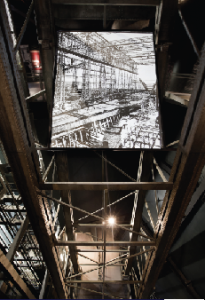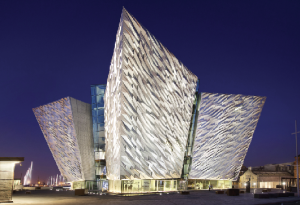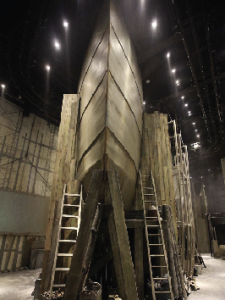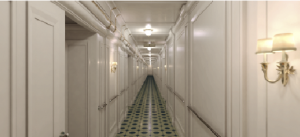Museum eye
Published in 20th-century / Contemporary History, Feature Article, Issue 3 May/June2013, Reviews, Volume 21Titanic Belfast
Titanic Quarter, Belfast
www.titanicbelfast.com
by Tony Canavan

The lift of the reconstructed Arrol gantry and (on screen) the original that surrounded the hull during construction.
Located in an iconic building, Titanic Belfast opened to a fanfare of publicity, promising to be a world-class visitor attraction in Northern Ireland. A year later it has met its target for visitor numbers and has sustained its PR campaign. Its setting is a bonus, as it occupies part of the shipyard where the great ship was built and affords spectacular views of the River Lagan and the city beyond.
Once inside, it becomes clear that the exhibition is dedicated to the building of the Titanic, celebrating Belfast as an industrial centre. There is much to see and at times it became sensory overload, as there are numerous videos, 3D displays, interactive screens and voice-overs all running at the same time in many of the galleries. Rather like the original ship, the building has so many compartments that there is not enough space here to describe them all. Of the nine galleries, the first gives a cursory introduction to Belfast, with a passing reference to the Home Rule crisis and none at all to the sectarian tensions in the city at that time.
One is not encouraged to linger long here, however, as the other galleries beckon. From a museum point of view, there is little in the way of actual artefacts, although there are reconstructions and models. The building is the main attraction, with its reproduction of the Harland & Wolff shipyard gates, the Arrol gantry (which surrounded the hull during construction), a lift to fly up the gantry and the ‘shipyard yard ride’.

Above: The iconic Titanic Belfast building—its setting is a bonus, as it occupies part of the shipyard where the great ship was built and affords spectacular views of the River Lagan and the city beyond.
The best things about the exhibition are non-museum-like. In the shipyard ride a cable-car does a high-wire loop around a simulation of the Titanic’s hull under construction. A voice-over explains the building techniques as you pass scaffolding and tools, while screens show men at work putting in rivets to hold the plates together. The famous 3D chamber is spectacular. Three sides of the room are huge screens and you are taken on a virtual tour of the ship, beginning at keel level and rising up through the engine room, cabins and so on until you come to a halt on the bridge. If the room is crowded, however, it can be difficult to appreciate the full effect. The small gallery on the sinking is effective for being minimalist. Dashes and dots along the black walls represent Morse code; transcripts of the ship’s last telegrams adorn the walls; a video shows just how she sank; and voice-overs play eyewitness accounts.
One gallery deals with the aftermath of the sinking. There are details of the deaths and survivors and a lifeboat, alongside big screens that play dramatic reconstructions of the British and American enquiries. One of the few original artefacts is on display here, a 32ft-long technical plan of the ship, which was used in both enquiries. The section labelled ‘myths and legends’ ignores the oral tradition and instead concentrates on verse, drama and of course film versions. The video of Celine Dionne singing the theme song from the 1997 blockbuster is enough to make anyone jump overboard.

In the ‘shipyard ride’ a cable-car does a high-wire loop around a simulation of the Titanic’s hull under construction, including the prow (seen here).
A final display gives an upbeat view of Belfast today. This reflects the general tenor of the whole exhibition, which is a celebration of what a great industrial city Belfast was and how everyone was proud of the shipyard and the Titanic. This is far from reflecting the complex and often contradictory reality. Next is a theatre whose giant screen runs a loop of footage of the wreck filmed by robot submarines, while on the floor below a series of interactive screens enable you to ‘explore’ the wreckage for yourself. Almost as an afterthought, there is a small gallery about underwater exploration.
Does it work as an experience? My reactions are mixed. It is certainly not well laid out. The route through the galleries does not flow. I noticed that many visitors were confused about where to go next. You are given a map, but the lighting throughout is so low that it is almost impossible to read. Makeshift signs run off on a PC are stuck up all over the place, guiding the visitor to the next gallery or the exit. I paid the extra for the audio guide but gave up on it because the audio points are not well marked and there is so much noise in every gallery that it was difficult to hear it.
Groups can book a guided tour and I recommend going on one of those. There were many local families there on the day I went but it was the Easter holiday. I did notice, however, that the teenagers showed little interest while younger children quickly got bored. There were many outside visitors from the Republic, Italy, America and elsewhere. As they had come specifically to see Titanic Belfast, they dutifully went from display cabinet to display cabinet. There are many staff about but they appear to serve no purpose, although one might start explaining an exhibit for no apparent reason.

One of the ship’s corridors, as shown in the spectacular 3D chamber in Gallery 4. Three sides of the room are huge screens and you are taken on a virtual tour of the ship, beginning at keel level and rising up through the engine room, cabins and so on until you come to a halt on the bridge.
(All images: Titanic Belfast)
On leaving, my conclusion was that, like the Giant’s Causeway, Titanic Belfast is worth seeing but not worth going to see. Apart from the commendable motive of attracting tourists to Belfast, it is difficult to discern the purpose of the project. Actual artefacts from the ship are on display in the United States, along with reconstructions, which give a more ‘real’ experience than 3D imagery. Apart from the concentration on the ship’s construction, you learn little new about the Titanic or her sinking.
On the other hand, it is an interesting experience but more in a theme-park kind of way. The gantry lift, the shipyard ride and the virtual tour are fun. It is almost worth going just for those. The location is also a big plus and on a sunny day the views out the windows are spectacular. Can we expect more? After all, Titanic Belfast is not really a museum but an entertainment attraction that is instructive to a certain degree. HI
















